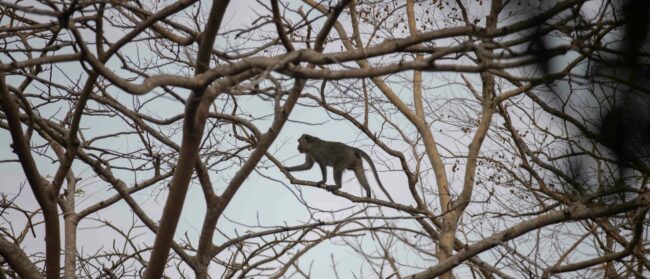What comes to mind when you think of public space in Saigon?
Surely parks such as Tao Dan or Le Van Tam, as well as the Nguyen Hue pedestrian street? These areas are certainly popular, but there is no denying that Saigon has a serious shortage of public space — and particularly green space.
According to Tuoi Tre, the metropolis has just 0.55 square meters of public park per resident, compared to 30.3 square meters per person in Singapore and 41 square meters per person in Seoul. Granted, those are far wealthier cities, but the contrast is stark, and it’s hard not to notice the lack of green here.
When discussing public space in the city, it’s useful to get an idea of what exactly that concept means.

“In the context of Vietnam, we have a specific understanding of public space,” said Phạm Thái Sơn, a senior lecturer in urban economics and part of the Sustainable Urban Development master study program at the Vietnamese-German University in Binh Duong. “The familiar things are something that you can easily access without any kind of serious consideration regarding accessibility.”
Given this, private spaces are sometimes considered public in Vietnam, such as supermarkets and commercial centers. Malls such as the one at Landmark 81, for example, are arguably just as popular as an air-conditioned place to hang out as they are for actually shopping.
It’s important to have a safe space, but during the day it absolutely doesn’t work because there is no shade
Sơn used the pedestrian area along Nguyen Hue as an example of the good and bad of public spaces in Saigon: “Can it be considered a green pedestrian street? Not really, as right now you have something in between two big streets that border it, and there is no direct connection between the so-called pedestrian street and sidewalks or shops on either side.”
However, the area is extremely popular, especially in the evening, across age and socioeconomic demographics. “I think it’s become a space that provides inclusive access to all groups of people,” he went on. “You can see the poor, the rich, the young and the old.”
“People criticize Nguyen Hue, but its existence is very good, as it’s an opportunity to create events and it’s the biggest pedestrian-only space in the city, so it’s very successful,” said Olivier Souquet, architect partner chairman at De-So, an architecture and urban planning design firm. “It’s important to have a safe space, but during the day it absolutely doesn’t work because there is no shade.”
Nguyen Hue has certainly worked well for events, from the Tet flower street to the raucous screenings of international soccer tournaments that the men’s national team has participated in over the last few years.


An example of a privately owned space that can be considered somewhat public is Vinhomes Central Park, one of the most spacious green areas in Saigon.
Sơn, however, argues that this is not an effective, inclusive space. “The users of this park are of course mostly residents of the complex, and some visitors, but most are middle-class or upper-middle-class … it is a clear demonstration of social separation, which is something I’m concerned about.”
Clement Musil, a public spaces researcher, shares Sơn’s concern about Central Park’s social stratification: “It’s huge, and there’s nothing else like it in Binh Thanh, so it’s good for the city as it can say there is this space, but is it really accessible to all? Would migrant workers be welcome? It’s very middle class.”
Linear Public Spaces
An important thing to keep in mind, Souquet argues, is that public areas in a tropical climate like Saigon’s should be linear. The grand plazas and squares of Europe would not make sense here, given the frequent rain and year-round hot temperatures.
De-So took part in a competition to design a large public space for the Thu Thiem New Urban Area, and the city government asked them to create a plaza, but De-So declined: “I didn’t want to because there is no shade. Public space in Vietnam is linear.”
Nguyen Hue is, of course, linear, while the refurbished pathways along the Thi Nghe-Nhieu Loc Canal can also be considered a public space, and quite an effective one as well, argues Fanny Quertemp, an urbanist who studies Saigon. “People can exercise, there is space for dogs, and it is separated from the street so it’s safe for people to be in without worrying about vehicles,” she said.
Another example is the book street near the Notre Dame Cathedral. “It’s human-scale, and it has shade, so you can have a coffee while being outside,” Souquet said.

Initiatives should come from a small scale with consistent action from the government with community participation in order to improve green, open spaces in Saigon
Aim Small
Sơn, for his part, argues that city planners should focus on smaller, community-scale public spaces, particularly as so many districts are already heavily developed.
“Initiatives should come from a small scale with consistent action from the government with community participation in order to improve green, open spaces in Saigon,” he said. “There are critical issues such as lack of community space where people can easily gather and have daily interactions. We have real trouble with this issue.”
He goes on: “We can talk about some new urban areas that provide a kind of public neighborhood space, but I’m not sure of the level of success of these areas because the number of people using them is not promising. For example, if you have a community of 2,000 people and only 100 people use it, that’s not successful.”
The recently opened park on the Thao Dien side of the Saigon Bridge is an example of a smaller public space with multiple functions, though it is currently separated from the community by a busy street with few pedestrian crossings.
“But, it’s well-designed and can be connected to the riverfront,” Quertemp shared. “It’s not perfect, but it fits in with discussions to redesign the riverfront.”
Souquet also believes the riverfront is key to Saigon’s future livability. “The Saigon River will define the future of public space. Like many countries, the river defines the boundary of the city, but now it will be included within the city.”
Currently, the municipal People’s Committee plans to have a linear public space along the Thu Thiem side of the river, which would connect to Nguyen Hue via a pedestrian bridge. It remains to be seen exactly when — or if — that will become reality given Thu Thiem’s sluggish overall progress, but such a reality would be groundbreaking for the city.
Sơn, meanwhile, worries about the scale of the plans for Thu Thiem: “Most of the public spaces there will be large-scale, which are good for huge public gatherings, but not for small community interactions, which are very important. I think we need a change from the cultural root — we should design public spaces with a human-centered approach, and we don’t have this right now.”

Quality, Not Quantity
Moving forward, urban developers also need to ensure that green public space can actually be used, and is not simply there to fill a quota.
“Developers of residential complexes have to provide a certain amount of square meters of green space per resident,” Musil said. “However, grass next to a road is considered green space, even if it can’t be used. On the city level, the grass in the middle of Mai Chi Tho Boulevard counts toward total green space, but it’s unusable as it’s in the middle of a highway.”
Such spaces also need to be accessible to all, including differently abled people or those with limited mobility. Sơn interviewed a number of such individuals last year, they shared that public spaces in Saigon are extremely difficult for them to utilize.
He also argued for a rethink of spaces that are currently dedicated to commercial activity: “We should focus on how to make use of more traditional public spaces in Vietnam so that areas around traditional markets or in small alleyways can be used by all. We should also promote giving back sidewalks to pedestrians and the community, as it’s very difficult to walk here.”

To be sure, efforts have been made in this area, most notably a campaign spearheaded by former District 1 Vice Chairman Đoàn Ngọc Hải in 2017, but with limited success, as anyone who regularly walks in Saigon can attest to.
There have been some positive steps: the small Thao Dien park mentioned above, and the recently reopened (again) area in front of the Opera House, which should provide respite for pedestrians once the trees grow in. Grand plans are also envisioned for a pedestrianized Le Loi, and a lavishly redesigned September 23 Park, though those fall very much into the “wait and see” category.
The battle, in Souquet’s mind, is between an economic approach and public space approach: “I don’t say one is better than the other, but today this question of what is a public space in Vietnam is the most important question. The reference right now is Singapore; when I meet planners and officials they speak about Singapore. Yes, it’s very nice, but the public spaces there are empty. What do you want to choose?”
This story was originally published on Saigoneer here.


